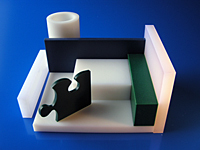
1029 Pulinski Rd Ivyland,
PA 18974
Tel:215-672-5225
Fax:215-672-5582
Email: sales@tridentplastics.com
Website: www.tridentplastics.com
PA 18974
Tel:215-672-5225
Fax:215-672-5582
Email: sales@tridentplastics.com
Website: www.tridentplastics.com

HDPE has a low degree of branching and thus stronger intermolecular forces and tensile strength. HDPE can be produced by chromium/silica catalysts, Ziegler-Natta catalysts or metallocene catalysts. The lack of branching is ensured by an appropriate choice of catalyst (e.g. Chromium catalysts or Ziegler-Natta catalysts and reaction conditions.

| Items |
 2624-0300 High Density Polyethylene - Natural (White) Rod |
 2624-0500 High Density Polyethylene - Natural (White) Rod |
 2624-0700 High Density Polyethylene - Natural (White) Rod |
 2624-0900 High Density Polyethylene - Natural (White) Rod |
 2624-1000 High Density Polyethylene - Natural (White) Rod |
|||||
| Weight | N/A 0.020 lb/ft | N/A 0.044 lb/ft | N/A 0.078 lb/ft | N/A 0.119 lb/ft | N/A 0.178 lb/ft | |||||
| Density (ASTM D792) | N/A 59.88 lb/ft³ | |||||||||
| Hardness - Durometer - Shore D (ASTM D2240) | N/A 67 | |||||||||
| Tensile Strength at Break (ASTM D638) | N/A 4423 psi | |||||||||
| Tensile Modulus (ASTM D638) | N/A 224812 psi | |||||||||
| Elongation - Yield (ASTM D638) | N/A 18 % | |||||||||
| Tensile Elongation, Break | N/A 1350 % | |||||||||
| Flexural Modulus | N/A 166796 psi | |||||||||
| Izod Impact | N/A 1.3 ft·lb/in | |||||||||
| Izod Impact Strength - Notched at 73ºF (ASTM D256) | N/A 3 ft·lb/in | |||||||||
| Tensile Impact Strength (DIN 53448) | N/A 570 ft·lb/in² | |||||||||
| Coefficient of Linear Thermal Expansion | N/A 6.7 x 10-5 in/in/ºF | |||||||||
| Maximum Operating Temperature | N/A 180 ºF | |||||||||
| Volume Resistivity (ASTM D257) | N/A > 1015 ohm·cm | |||||||||
| Standard Length | N/A 10 ft4 ft8 ft | |||||||||
|
|
||||||||||